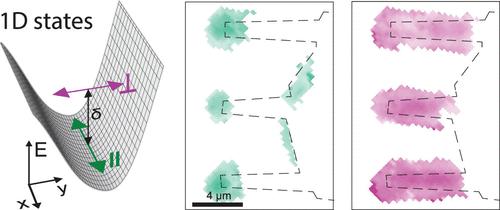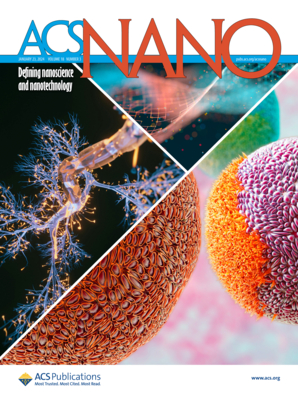MoSe2中的谷杂化栅极可调一维激子约束
IF 15.8
1区 材料科学
Q1 CHEMISTRY, MULTIDISCIPLINARY
引用次数: 0
摘要
在半导体材料中控制纳米尺度的激子是量子光子学和光电子学领域的一项艰巨挑战。过渡金属二掺杂化合物(TMDs)单层材料具有固有的二维约束能力,并具有显著的激子结合能,因此是实现基于电场的激子约束而不解离的理想候选材料。利用与这些约束态相关的谷自由度进一步拓宽了激子工程的前景。在这里,我们展示了对 MoSe2 中一维(1D)量子约束态发射的光偏振的电控制。在之前关于可调捕获电势和线性偏振发射的报道基础上,我们通过展示非均匀面内电场如何实现对这些效应的原位控制,并强调了门控可调谷杂化在这些局部态中的作用,从而扩展了这一认识。它们的极化完全可以通过一维约束势的几何形状或平面外磁场来实现。控制 TMD 中的非均匀面内电场可以控制一维约束激发态(5 nm V-1)的能量(高达其线宽的五倍)、极化状态(从圆形到线性)和位置。本文章由计算机程序翻译,如有差异,请以英文原文为准。

Valley-Hybridized Gate-Tunable 1D Exciton Confinement in MoSe2
Controlling excitons at the nanoscale in semiconductor materials represents a formidable challenge in the quantum photonics and optoelectronics fields. Monolayers of transition metal dichalcogenides (TMDs) offer inherent 2D confinement and possess significant exciton binding energies, making them promising candidates for achieving electric-field-based confinement of excitons without dissociation. Exploiting the valley degree of freedom associated with these confined states further broadens the prospects for exciton engineering. Here, we show electric control of light polarization emitted from one-dimensional (1D) quantum-confined states in MoSe2. Building on previous reports of tunable trapping potentials and linearly polarized emission, we extend this understanding by demonstrating how nonuniform in-plane electric fields enable in situ control of these effects and highlight the role of gate-tunable valley hybridization in these localized states. Their polarization is entirely engineered through either the 1D confinement potential’s geometry or an out-of-plane magnetic field. Controlling nonuniform in-plane electric fields in TMDs enables control of the energy (up to five times its line width), polarization state (from circular to linear), and position of 1D confined excitonic states (5 nm V–1).
求助全文
通过发布文献求助,成功后即可免费获取论文全文。
去求助
来源期刊

ACS Nano
工程技术-材料科学:综合
CiteScore
26.00
自引率
4.10%
发文量
1627
审稿时长
1.7 months
期刊介绍:
ACS Nano, published monthly, serves as an international forum for comprehensive articles on nanoscience and nanotechnology research at the intersections of chemistry, biology, materials science, physics, and engineering. The journal fosters communication among scientists in these communities, facilitating collaboration, new research opportunities, and advancements through discoveries. ACS Nano covers synthesis, assembly, characterization, theory, and simulation of nanostructures, nanobiotechnology, nanofabrication, methods and tools for nanoscience and nanotechnology, and self- and directed-assembly. Alongside original research articles, it offers thorough reviews, perspectives on cutting-edge research, and discussions envisioning the future of nanoscience and nanotechnology.
 求助内容:
求助内容: 应助结果提醒方式:
应助结果提醒方式:


